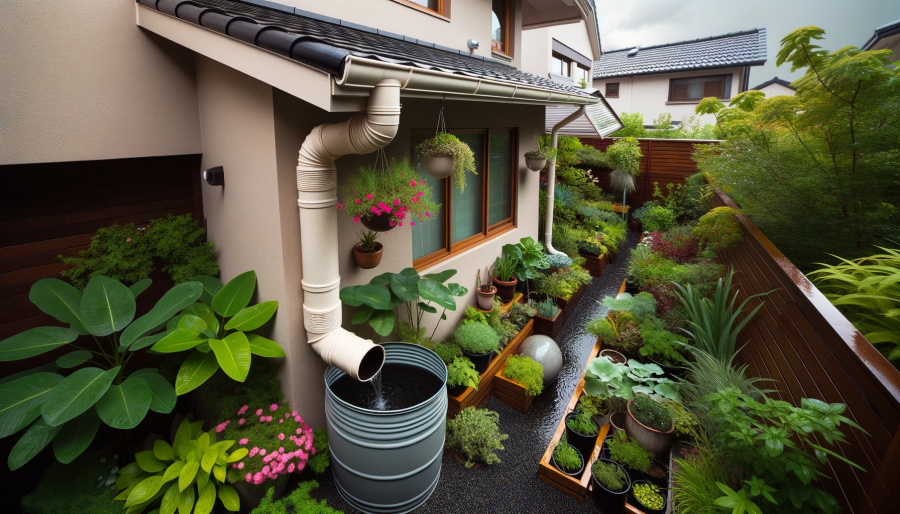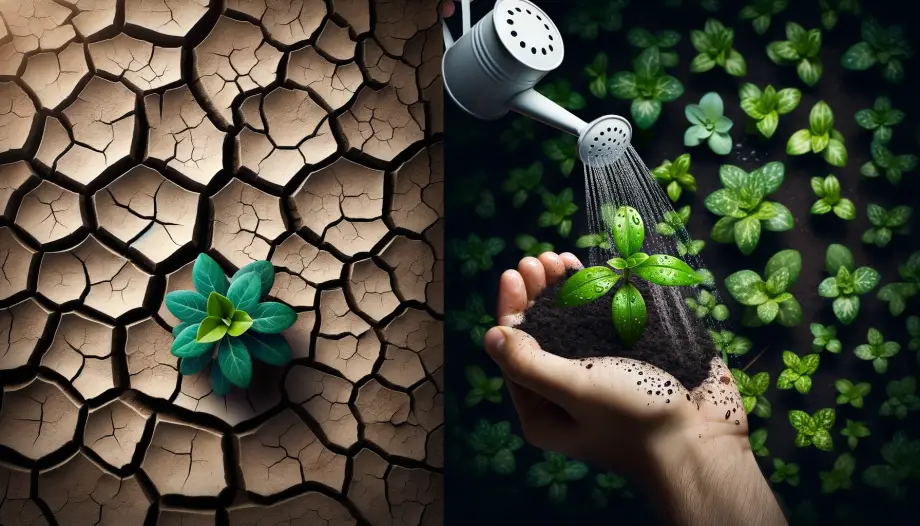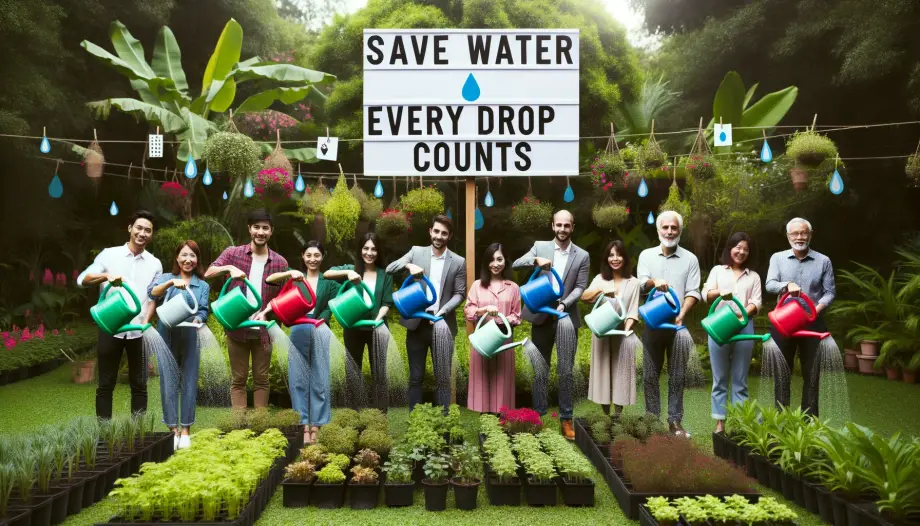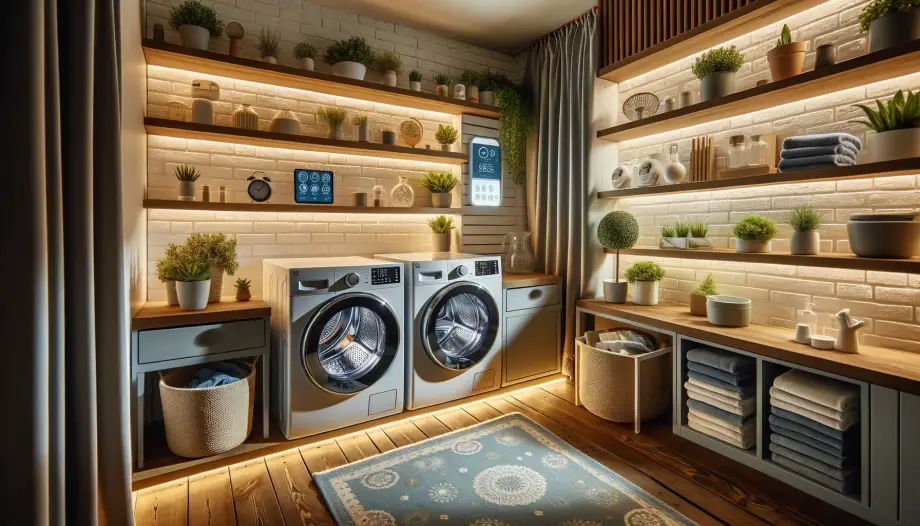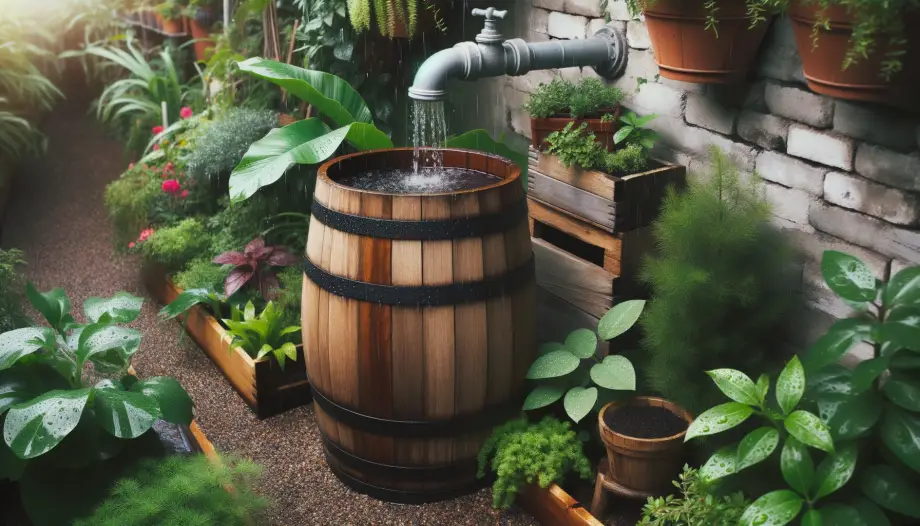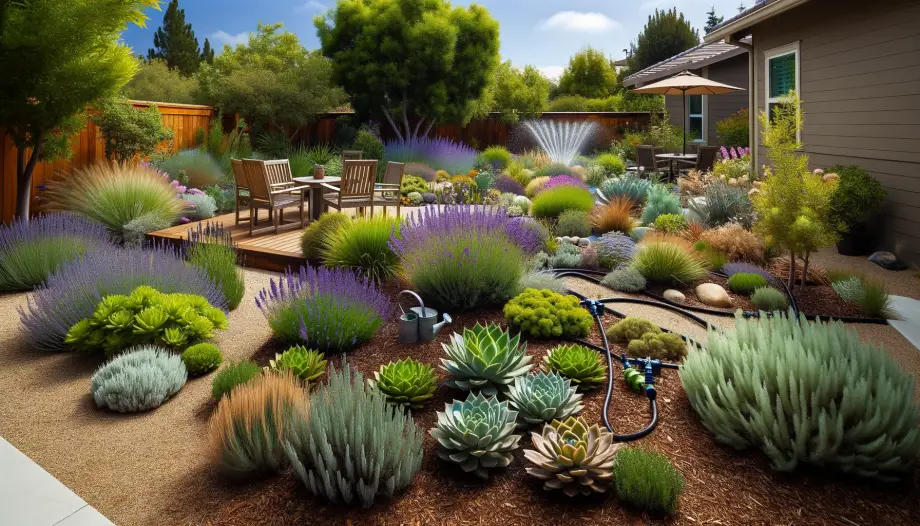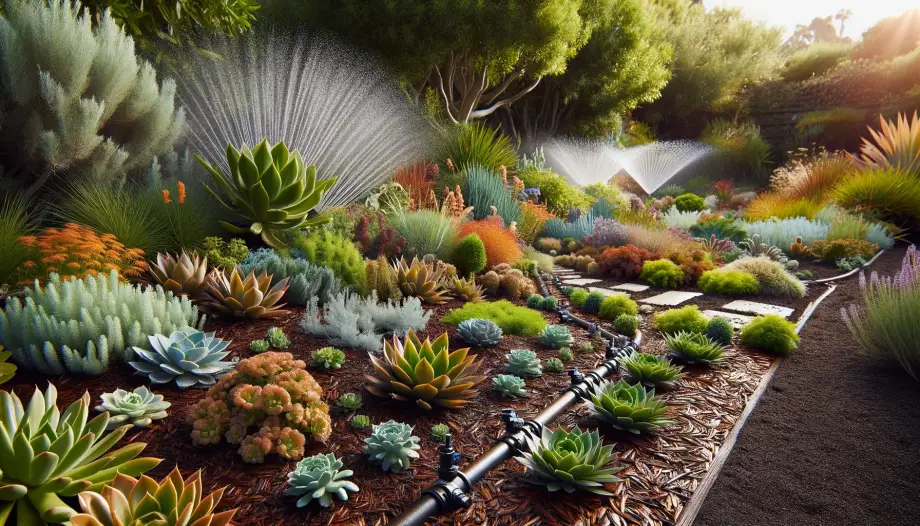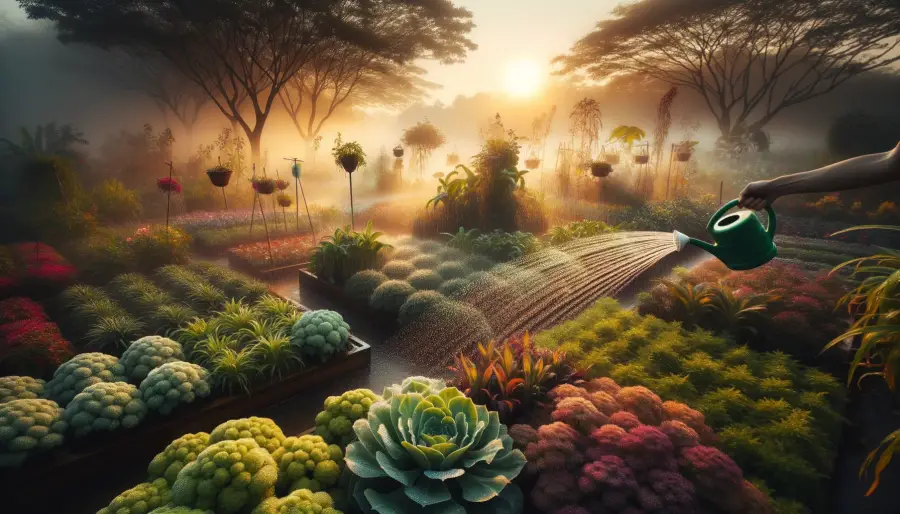
Discover practical tips on how to save water outside and make a positive environmental impact. Our guide unveils easy steps to conserve water in your outdoor spaces.
Saving Water Outside Key Takeaways:
- How to save water outside involves:
- Collecting rainwater
- Employing efficient watering practices
- Optimizing irrigation systems
- Choosing drought-tolerant plants
- Utilizing water-saving equipment.
- Implementing these measures will significantly reduce outdoor water consumption, promoting a sustainable and eco-friendly environment.
I. How To Save Water Outside in Your Garden
Wondering how to save water outside and contribute to a greener planet? You’re in the right place!
Our comprehensive guide is brimming with actionable tips and smart techniques that will transform your outdoor spaces into a haven of water efficiency.
It’s all about making small changes that yield big results. So, let’s embark on this water-saving journey together and make every drop count!
Water, the elixir of life, not only nourishes us but also embellishes our outdoor spaces, making them verdant and vibrant.
However, the reality of dwindling water resources is hitting hard, making water conservation outside an essential practice to adopt.
This section delves into the significance of water-saving in outdoor settings, the influence of outdoor water use on our total household water consumption, and an overview of effective strategies for minimizing water usage outdoors.
Importance of Water Conservation in Outdoor Settings
The bliss of having a lush garden and a spotless driveway comes at the cost of gallons of water.
With the planet grappling with water scarcity, it’s imperative to adopt water conservation measures in our outdoor spaces.
Reducing water usage outdoors not only contributes to conserving this precious resource but also sets a precedent of environmental responsibility in our communities.
The Impact of Outdoor Water Usage on Overall Household Water Consumption
An astonishing chunk of our water bill comes from outdoor water usage.
From sprinkling lawns to washing vehicles, the gallons of water used outdoors significantly pump up household water consumption.
It’s not just about the water bill, but the larger picture of water conservation.
By curbing outdoor water usage, households can play a pivotal role in reducing overall water consumption, making a positive impact on the environment.
Overview of Effective Strategies for Water Conservation Outdoors
Water conservation outdoors isn’t a monolithic task; rather, it comprises small changes that can lead to substantial water savings.
Strategies like utilizing rain barrels, watering plants in the early morning or late evening, and employing efficient irrigation systems like drip systems, can significantly cut down on water usage.
Adopting a holistic approach towards outdoor water use, from choosing native plants to fixing leaky faucets, can pave the way towards a sustainable and beautiful landscape, promoting a culture of water conservation that transcends the individual household and benefits the broader community.
II.Harvesting Rainwater
The allure of rainwater is not just in its purity, but also in the immense potential it holds for outdoor water conservation.
Harvesting rainwater through various methods not only serves as a buffer during dry spells but also significantly reduces outdoor water use.
This segment explores the facets of rainwater harvesting through installing rain barrels and creating a rain garden, each contributing to a substantial reduction in water consumption.
Installing Rain Barrels
- Benefits of Using Rain Barrels: Capturing rainwater in barrels is a simple yet effective method to conserve water. The collected water can be used for a myriad of outdoor tasks such as watering plants, cleaning outdoor areas, and even for topping up the swimming pool. By doing so, households can save gallons of water, reducing the water bill and lessening the demand on local water supply.
- Legal Considerations and Local Regulations: Before jumping on the rain barrel bandwagon, it’s prudent to check local regulations as some regions have restrictions on rainwater harvesting. Ensuring compliance with local laws is crucial to avoid any legal ramifications and to foster a community-wide culture of lawful water conservation1.
Creating a Rain Garden
A rain garden is not only an aesthetically pleasing feature but also a functional one in terms of water conservation.
It’s designed to capture runoff rainwater, allowing it to percolate into the ground, recharging the local groundwater table.
By directing rainwater to a rain garden, households can prevent water run-off, which often carries pollutants into local waterways, and at the same time, create a beautiful landscape that requires little to no additional water.
The plants chosen for rain gardens are usually native plants that thrive in the natural water conditions of the area, further promoting the concept of water conservation while enhancing the local ecosystem.
Utilizing Collected Rainwater for Various Outdoor Tasks
Harnessing the bounty of nature, especially the free and pure rainwater, is a smart move towards sustainable living.
The collected rainwater can be a boon, serving myriad purposes outdoors while significantly trimming down the water bill.
- Watering Plants and Lawns: Employing collected rainwater to quench the thirst of your outdoor plants and lawns is one of the easiest ways to cut back on tap water usage. Rainwater is typically free of the salts and chemicals found in groundwater or municipal water supplies, making it a healthier choice for your green buddies.
- Cleaning Outdoor Areas: Whether it’s washing the patio, cleaning garden tools, or rinsing the muddy pathways, utilizing rainwater is a great way to get the chores done without tapping into the precious fresh water supply.
- Filling Bird Baths and Ornamental Water Features: Refilling bird baths or ornamental water features with collected rainwater is an eco-friendly way to maintain the aesthetics of your garden while conserving water.
- Topping Up Swimming Pools and Ponds: Evaporation can lead to significant water loss from swimming pools and ponds. Using collected rainwater to top them up can save a substantial amount of water over time.
- Car Washing: A bucket of soapy water from the collected rainwater can be used to wash your car, conserving a considerable amount of water that would otherwise come from the hose.
- Compost Moistening: Keeping the compost pile moist is essential for its decomposition, and what better way to do it than using collected rainwater. It’s an eco-conscious choice that promotes recycling and water conservation hand in hand.
- Fire Protection: In regions prone to wildfires, having a reserve of rainwater can be a lifesaver. It can be used to dampen the surroundings and act as an emergency water source.
Utilizing rainwater for these outdoor tasks is not just a step towards lessening water consumption, but also a leap towards a sustainable and environmentally friendly lifestyle.
Through these simple yet effective uses of collected rainwater, every drop counts towards a meaningful water conservation effort.
III. Efficient Watering Practices

Efficient watering is the cornerstone of water conservation in outdoor spaces.
By adopting smart watering practices, not only can one save gallons of water but also ensure that plants receive the right amount of water for healthy growth.
This segment covers the optimal timing for watering, the importance of watering at the root zone, the utilization of soil moisture meters, and the strategy of creating distinct watering zones based on the varied needs of plants.
Timing of Watering (Early Morning or Late Evening):
Watering plants either in the early morning or late evening can significantly reduce water evaporation, ensuring that more water reaches the plant’s roots.
These timings are favorable as the temperatures are cooler and the wind speed is typically lower, reducing water loss and making watering more effective.
Watering at the Root Zone to Minimize Evaporation:
Directing water to the plant’s root zone minimizes evaporation and ensures that water is absorbed where it’s needed most. Drip irrigation systems or soaker hoses are excellent tools for delivering water straight to the roots, promoting healthier plant growth while conserving water.
Utilizing Soil Moisture Meters to Prevent Over- or Under-Watering:
Soil moisture meters are invaluable gadgets in preventing both over- and under-watering.
By accurately measuring the moisture level at the root zone, these devices help in determining when and how much water your plants need, ensuring that no water is wasted1.
Creating Watering Zones Based on Plant Needs:
Grouping plants with similar watering needs and creating distinct watering zones is a smart strategy for efficient water use.
This approach allows for tailored watering schedules that meet the specific needs of different plant types, ensuring that each plant receives enough water without any wastage.
The practice of grouping plants also fosters a healthier plant growth environment and reduces overall outdoor water use, making your garden both beautiful and water-efficient.
IV. Optimizing Irrigation Systems
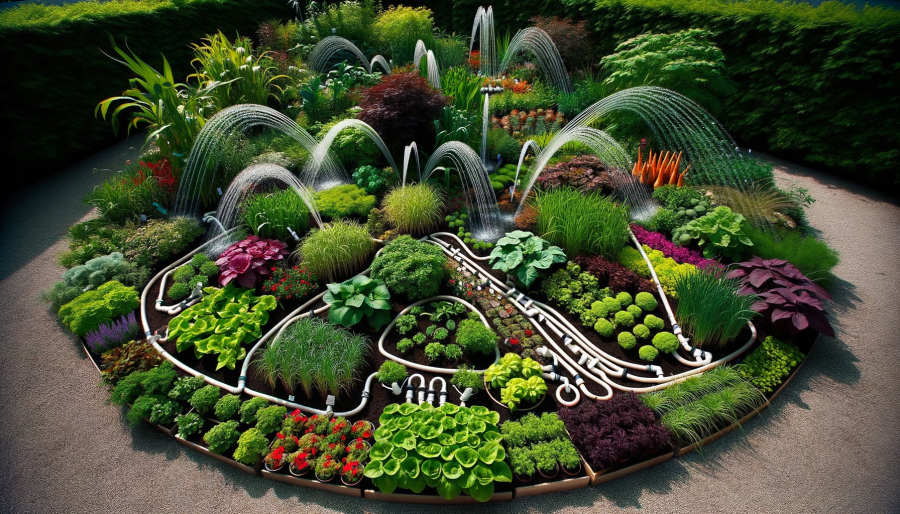
A well-optimized irrigation system is synonymous with efficient outdoor water use.
It’s not just about watering the plants; it’s about doing it smartly to avoid any waste.
This section delves into the adjustment of sprinklers to prevent water wastage, the implementation of smart irrigation controllers for enhanced water management, and the importance of regular inspection and maintenance to keep the irrigation system in top-notch condition.
Adjusting Sprinklers to Avoid Water Wastage:
Sprinklers can be both a boon and a bane. While they automate the watering process, incorrect settings or misaligned sprinkler heads can lead to substantial water wastage.
Adjusting the sprinklers to ensure they water the plants and not the pavements is a step towards efficient water use.
Ensuring that the sprinkler heads are properly aligned and the system is set to operate during the early morning or late evening can contribute to significant water savings.
Implementing Smart Irrigation Controllers:
The advent of smart irrigation controllers has revolutionized outdoor water management.
These controllers adjust the watering schedule based on weather conditions, soil moisture levels, and other factors, ensuring that the landscape receives just the right amount of water.
By automating water conservation, smart irrigation controllers not only reduce water usage but also lower the water bill, making them a worthy investment for the eco-conscious homeowner.
Regular Inspection and Maintenance to Fix Leaks:
A small leak can result in a big waste. Regular inspection and maintenance of the irrigation system are paramount to ensure it’s functioning optimally.
Checking for leaks, broken lines, or blocked sprinkler heads, and fixing them promptly can prevent gallons of water from being wasted.
Additionally, seasonal tune-ups by professionals can enhance the efficiency of the irrigation system, ensuring that it operates flawlessly to provide the necessary water to the landscape without any excess.
V. Garden and Lawn Care
The choices made in garden and lawn care play a pivotal role in outdoor water conservation.
The selection of plants, application of mulch, and the mowing settings can either lead to water savings or excess consumption.
This section explores how making informed choices in these aspects can significantly contribute to water conservation while keeping your outdoor spaces green and inviting.
Choosing Drought-Tolerant Plants and Ornamental Grasses:
Drought-tolerant plants and ornamental grasses are the heroes of a water-efficient garden.
They require much water less compared to their thirsty counterparts. Native plants, in particular, are acclimated to the local weather conditions and soil types, thereby requiring minimal watering.
Incorporating a variety of these plants and grasses not only reduces water consumption but also creates a low-maintenance, beautiful landscape.
Applying Mulch to Retain Soil Moisture:
Mulch acts as a protective blanket for the soil, retaining moisture, reducing evaporation, and preventing weed growth which competes for water.
A good layer of mulch around plants and on bare soil surfaces can significantly cut down on water needs.
Additionally, organic matter in the mulch gradually decomposes, enriching the soil and promoting better water retention.
Mowing at a Higher Setting to Shade the Soil and Reduce Evaporation:

The height at which you mow the lawn can impact water conservation.
Mowing at a higher setting allows grass to grow taller, which in turn shades the soil, reducing evaporation.
Longer grass also develops deeper root systems, enabling it to access moisture at greater soil depths.
Adjusting the lawn mower to a higher setting is a simple yet effective step toward reducing outdoor water use while promoting a lush, green lawn.
VI. Water-Saving Equipment and Technologies
In the quest for outdoor water conservation, leveraging modern equipment and technologies can be a game-changer.
These innovations are designed to minimize water wastage and promote efficient water use, which is crucial in fostering a culture of sustainability.
This section discusses the employment of automatic rain shutoff devices, upgrading to water-efficient emitters, and the use of shut-off nozzles on garden hoses as some of the technologically driven means to save water outdoors.
Employing Automatic Rain Shutoff Devices:
Automatic rain shutoff devices are smart gadgets that prevent irrigation systems from watering landscapes when it’s raining.
They are equipped with sensors that detect rain, thereby shutting off the irrigation system, ensuring that not a drop of water is wasted.
By adopting such intelligent devices, homeowners can significantly cut down on water consumption, contributing to a substantial reduction in the water bill and promoting water conservation.
Upgrading to Water-Efficient Emitters:
Water-efficient emitters are designed to regulate the water flow in irrigation systems, ensuring that each plant receives the right amount of water.
By upgrading to these emitters, one can prevent over-watering and ensure that water is distributed uniformly across the garden.
This not only leads to healthier plant growth but also contributes to significant water savings, making the garden a haven of efficiency and sustainability.
Using Shut-Off Nozzles on Garden Hoses:
Shut-off nozzles are simple yet effective tools for controlling water flow from garden hoses. By installing a shut-off nozzle, one can easily control the water flow, ensuring that water is only used when needed.
This simple addition can lead to a noticeable reduction in water usage, making each watering session a step towards a water-efficient outdoor space. It’s about having control over the water flow, reducing wastage, and making every drop count towards nurturing the garden.
VII. Xeriscaping for Water Conservation
Embracing xeriscaping is like tuning into nature’s rhythm, allowing for a beautiful, sustainable, and water-efficient outdoor environment. It’s a landscaping philosophy that hinges on the selection of drought-tolerant plants, efficient irrigation practices, and the reduction of lawn areas, aiming for a significant cut in water usage.
Selecting Drought-Tolerant Plants:
Choosing plants that thrive with less water is the cornerstone of xeriscaping. Native plants or those adapted to the local climate require less watering and care, making them a wise choice for a water-conscious garden.
Efficient Irrigation Practices:
Incorporating drip irrigation systems or soaker hoses in a xeriscaped garden ensures that water reaches the root zone with minimal evaporation, contributing to water conservation while promoting healthy plant growth.
Reducing Lawn Areas:
Lawns are often water guzzlers. Reducing lawn areas or replacing traditional turf with drought-tolerant grass species can lead to substantial water savings. This not only conserves water but also creates a visually appealing and low-maintenance landscape that resonates with the ethos of sustainability.
Mulching and Soil Preparation:
Applying a layer of mulch and preparing the soil with organic matter not only retains soil moisture but also reduces weed growth, further minimizing the need for watering.
Designing with Purpose:
Thoughtful design is at the heart of xeriscaping. Planning garden layouts to include windbreaks, shade structures, and water features can create a beautiful landscape that requires little to no additional water, embodying the essence of water conservation in every aspect of the outdoor space.
VIII. Miscellaneous Tips
Beyond the garden and lawn, there are numerous other areas outdoors where water conservation practices can be employed. A few simple changes in how we manage our driveways, swimming pools, and cars can lead to notable water savings. This section offers miscellaneous tips that can be easily incorporated into our daily routines, contributing to a more water-efficient outdoor environment.
Sweeping Driveways and Patios Instead of Hosing Them Down:
A common practice is to hose down driveways and patios for cleaning, which uses a significant amount of water. Opting to sweep these areas instead can save gallons of water each time. It’s a simple switch, yet its impact on water conservation is substantial over time.
Covering Swimming Pools to Reduce Evaporation:
Uncovered swimming pools are a source of significant water loss due to evaporation, especially in the heat of the day. Covering the pool when it’s not in use can greatly reduce evaporation, saving a considerable amount of water. A pool cover also keeps the pool clean, reducing the need for frequent refilling.
Washing Cars with a Bucket or at Eco-Friendly Car Washes:
Instead of using a hose, washing cars with a bucket of soapy water can save a lot of water. Alternatively, opting for eco-friendly car washes that recycle water can also contribute to water conservation. These small changes not only reduce water usage but also promote a culture of water conservation, making every drop count in our fight against water wastage.
VIX. FAQs
In our journey towards water conservation, questions often arise regarding the practical steps that can be taken to save water, both at home and in public places. This section seeks to answer some of the frequently asked questions about water-saving practices, providing actionable tips that can be easily implemented.
Q: What are 10 ways to save water?
A:
- Collect rainwater for outdoor use.
- Water plants early in the morning or late in the evening to reduce evaporation.
- Fix any leaks in outdoor faucets and irrigation systems promptly.
- Install a smart irrigation system to optimize watering schedules.
- Replace traditional turf with drought-tolerant grasses or native plants.
- Apply mulch around plants to retain soil moisture.
- Use a pool cover to minimize evaporation from swimming pools.
- Sweep driveways and patios instead of hosing them down.
- Wash cars with a bucket of soapy water or at water-recycling car washes.
- Group plants with similar water needs together to create efficient watering zones.
Q: What are 5 ways to save water?
A:
- Collect and utilize rainwater.
- Water plants at the root zone to minimize evaporation.
- Maintain your irrigation system to prevent leaks and over-watering.
- Use a broom instead of a hose to clean outdoor areas.
- Upgrade to water-efficient emitters in your irrigation system.
Q: How can we save water in public places?
A:
- Report any leaks in public restrooms or water fountains to the authorities.
- Avoid wasting water in public restrooms by turning off taps when not in use.
- Encourage the installation of smart irrigation systems in public gardens and parks.
- Advocate for the use of drought-tolerant plants in public landscaping.
- Promote awareness about water conservation through community programs.
Q: How can I save water in my lawn?
A:
- Replace traditional lawn areas with drought-tolerant grass species or groundcovers.
- Water your lawn early in the morning or late in the evening to reduce evaporation.
- Install a smart irrigation system to optimize watering schedules.
- Mow your lawn at a higher setting to promote soil shading and reduce water loss.
- Aerate your lawn to improve water penetration and reduce runoff.
X. Conclusion
Our outdoor spaces are a reflection of our commitment to nurturing nature and conserving resources. As explored, numerous strategies, ranging from harvesting rainwater, employing efficient watering practices, to leveraging water-saving technologies can significantly reduce water consumption outdoors.
Recap of Key Points:
We delved into various water-saving practices such as utilizing rain barrels, optimizing irrigation systems, xeriscaping, and employing simple daily actions like sweeping instead of hosing down driveways. Each of these strategies contributes towards a substantial reduction in outdoor water usage, making our spaces more eco-friendly.
Encouragement to Adopt Water-Saving Practices Outdoors:
Adopting water-saving practices outdoors is a step towards a sustainable and responsible living. It’s about making small changes that cumulatively have a large impact on water conservation. As stewards of our environment, embracing these water-saving techniques will not only foster a culture of conservation but also inspire others in the community to follow suit, creating a ripple effect of positive environmental change.

